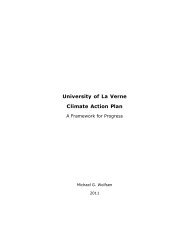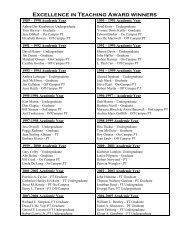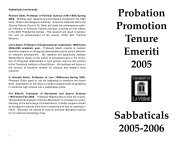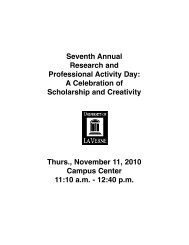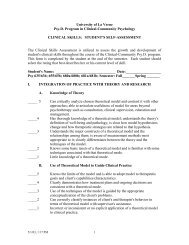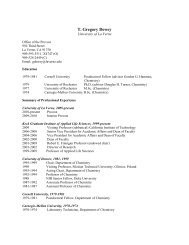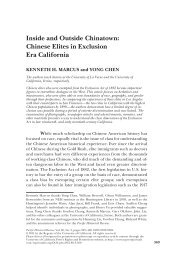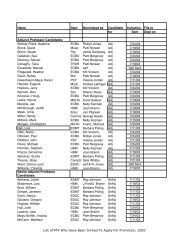CHEM â 103: Introduction to Chemistry - University of La Verne
CHEM â 103: Introduction to Chemistry - University of La Verne
CHEM â 103: Introduction to Chemistry - University of La Verne
Create successful ePaper yourself
Turn your PDF publications into a flip-book with our unique Google optimized e-Paper software.
<strong>CHEM</strong> – 201: General <strong>Chemistry</strong> IFall 2010SyllabusTR 8:00 – 9:30 AMInstruc<strong>to</strong>r:Dr. Ricardo MoralesMainiero Building (MA) 56BPhone: (909) 593-3511 x4620Email: rmorales@laverne.eduOffice Hours: Tue, Thu: 10-11 amW: 10:00 – 11:30 amText Books:Lecture: James E. Brady and Fred Senese, <strong>Chemistry</strong>: Matter and Its Changes, Fifth Edition,John Wiley & Sons, New York, 2008.<strong>La</strong>bora<strong>to</strong>ry: Jo A. Beran, <strong>La</strong>bora<strong>to</strong>ry Manual for Principles <strong>of</strong> General <strong>Chemistry</strong>, 8 th Edition,John Wiley & Sons, New York, 2009.<strong>CHEM</strong>ISTRY 201-2, General <strong>Chemistry</strong> I & IIOne year beginning chemistry course for science, engineering, and pre-health science students.PrerequisitesCompetent level <strong>of</strong> high school chemistry, mathematics, and physics, or <strong>Chemistry</strong> <strong>103</strong>(<strong>Introduction</strong> <strong>to</strong> <strong>Chemistry</strong>), or consent <strong>of</strong> the class instruc<strong>to</strong>r.Course DescriptionLecture portion shall include interaction <strong>of</strong> matter and electromagnetic radiation, behavior <strong>of</strong>electrons in a<strong>to</strong>ms and molecules, a<strong>to</strong>mic and molecular structures, chemical and physicalproperties <strong>of</strong> chemical dynamic systems, chemical bonding theories, and thermo-chemistry.Chemical calculations will be involved in most areas <strong>of</strong> chemical systems.<strong>La</strong>bora<strong>to</strong>ry, which is required for all students enrolled for this course, consists <strong>of</strong> experimentscorresponding <strong>to</strong> the subjects listed above.Objectives:Comprehensive treatment <strong>of</strong> <strong>to</strong>pics related <strong>to</strong> introduc<strong>to</strong>ry quantum chemistry, chemical bondingdynamics, and molecular behavior in this course is designed <strong>to</strong> promote better understanding <strong>of</strong>the interactions <strong>of</strong> man, matter and the environment. Using knowledge gained in lecture,labora<strong>to</strong>ry, reading, and homework assignments, students are expected <strong>to</strong> be able <strong>to</strong> solve basicchemical problems and understand the concepts related <strong>to</strong> the following <strong>to</strong>pics:• The Quantum Mechanical A<strong>to</strong>m and Bohr’s Model, units and dimensional analysis• A<strong>to</strong>ms, molecules, and ions; mole concept• Interaction <strong>of</strong> matter and electromagnetic waves, behavior <strong>of</strong> electrons in a<strong>to</strong>ms andmolecules, a<strong>to</strong>mic structure, and the periodic table. Chemical bonding and structure• Valence Shell Electron-Pair Repulsion theory and molecular shapes• Molecular orbital and Valence Bond theories• S<strong>to</strong>ichiometry and chemical reactions; acid-base equilibrium• Chemical thermodynamics, equilibrium, and chemical kinetics.• Intermolecular forces and state <strong>of</strong> matter (gas-liquid-solid)• Redox reactions, ion-electron methods and electrochemistry• Coordination compounds
Environmental CompliancePlease notice the safety codes and regulations require that extra care and caution be taken byevery student in handling all the chemicals while working in the labora<strong>to</strong>ry. All respective MSDS(Material Safety Data Sheets) copies are available in designated areas in the lab and also on thechemistry computer system. Before using or handling any chemical, make sure that you read andunderstand the information on the respective MSDS. No hazardous material may be disposedin<strong>to</strong> the sink. These materials must be s<strong>to</strong>red in designated containers for later treatmentand disposal. A pair <strong>of</strong> safety goggles with side guards for your eye protection and a lab coat isrequired at all times. Also, open shoes, such as sandals or shorts will not be permitted. Long hairmust be tied back. Students may never work alone in the labora<strong>to</strong>ry. <strong>La</strong>b technique is part <strong>of</strong>the <strong>to</strong>tal lab grade. You will need a lab note book and a scientific calcula<strong>to</strong>r.Classroom rules and AttendanceAttending lectures is important for you <strong>to</strong> master the course. Your attendance will be recorded.Try <strong>to</strong> be on time for each lecture and lab session. It is disrupting and inconsiderate when youcome <strong>to</strong> class late and disrupt the lecture discussion. Bring your textbook, periodic table andcalcula<strong>to</strong>r. Inappropriate behaviors will not be <strong>to</strong>lerated. Please turn <strong>of</strong>f all cell phones (or setthem in vibration) during class. I will not <strong>to</strong>lerate texting and cell phone ringing duringlectures as well as students talking during class (unsolicited conversation).Course Organization1. Lectures: Tuesdays and Thursday 8:00 – 9:30 A.M., <strong>La</strong> Fetra Audi<strong>to</strong>rium.Hour tests: Two such tests will be given during the semester. Each will cover all thematerial studied up <strong>to</strong> that time. These tests will be designed <strong>to</strong> be completed in onesession.2. <strong>La</strong>bora<strong>to</strong>ry:The lab schedule for the entire semester is attached. Prepare for your lab by answeringquestions in the Prelabora<strong>to</strong>ry assignments and as per lab instructions provided <strong>to</strong> you byyour lab Pr<strong>of</strong>essor, Dr. Ricardo Morales.3. Questions and Conferences: Only if you do not study hard enough you will have noquestions! Have your questions answered as soon as possible; the staff is eager <strong>to</strong> helpyou. Please do not hesitate <strong>to</strong> ask for an appointment or make use <strong>of</strong> the <strong>of</strong>fice hourswhenever we can assist you in the understanding the subject matter in this course.4. Makeup Policy: In accordance with the <strong>University</strong> policy, make-up assessments will befor an illness or unavoidable <strong>of</strong>ficial function <strong>of</strong> the <strong>University</strong>. Not being ready is not avalid excuse, and the time and date <strong>of</strong> the make-up will be at my convenience. Contactme prior <strong>to</strong> the date <strong>of</strong> the assessment if you are going <strong>to</strong> miss it for any reason. For aqualified make-up, make an arrangement with me. As noted on page 25 <strong>of</strong> the 2010-11<strong>University</strong> <strong>of</strong> <strong>La</strong> <strong>Verne</strong> Catalog, the <strong>University</strong> fee for a make-up exam is $40. No makeupquizzes will be done.5. Do not try <strong>to</strong> memorize your way through your learning process. With littlememorization, try <strong>to</strong> grasp the major concepts, facts, and basic principles and developlogic strategies <strong>to</strong> apply your knowledge <strong>to</strong> work the problems. For example, innaming chemicals, do not memorize the name <strong>of</strong> each compound. Instead, try <strong>to</strong> learn theconcepts and rules for naming the chemicals.6. <strong>University</strong> <strong>of</strong> <strong>La</strong> <strong>Verne</strong>’s Blackboard Course S<strong>of</strong>tware: I will use the Blackboardcourse s<strong>of</strong>tware as a means <strong>of</strong> communicating with you. This means that the e-mailmessages I will send out from Blackboard will au<strong>to</strong>matically go <strong>to</strong> your <strong>La</strong> <strong>Verne</strong> e-mailaddress. If you wish <strong>to</strong> receive messages using another e-mail address, that is fine,though you will need <strong>to</strong> go in<strong>to</strong> the preferences in your <strong>La</strong> <strong>Verne</strong> account and au<strong>to</strong>-
forward your mail <strong>to</strong> the address you choose. In addition, I will use Blackboard <strong>to</strong> postthe course-lab syllabus, my lecture notes in PowerPoint format, any handouts, thehomework answer keys for the assigned problems out <strong>of</strong> the textbook, old exams, etc.Grading Policy.Your final grade will be computed APPROXIMATELY as follows:Let: HT = your homework <strong>to</strong>tal 50 maxHE = the average <strong>of</strong> your two tests 260 maxFE = your final exam grade450 maxLT = your lab <strong>to</strong>tal240 maxThen, your final numerical grade comes from HT + HE + FE + LT. We do not know at this time,and will not predict, the exact letter grade boundaries.Homework assignments Fall 2010.To be turned in by dates defined by the instruc<strong>to</strong>r during the course. Because most <strong>to</strong>pics inchemistry are related and build on one another, it is important <strong>to</strong> work on and turn in assignmentsas they are due.In order <strong>to</strong> do well in this class, you need <strong>to</strong> spend enough time <strong>to</strong> read and learn from yourtext book, lab book and notes, and be prepared for the next class or lab.P: Practice exercise; R: Review Questions/ Problems#1 Ch. 1: P9, P11 Ch. 2: P1, P3, P4, P8, R9, R19, R86, R89#2 Ch. 2: P19, P24 (a,b), P32, R37, R50, R57, R59, R66#3 Ch. 2: R68, R91, R96, R101, R104, R107, R109#4 Ch. 2: R111, R112, R115, R117, R118, R121, R133, R135#5 Ch. 1: P8, P12, R27, R29, R56, R60, R83#6 Ch. 3: P1, P7, P17, P21, P23, P25, P27, P31, P33, R52, R57, R110#7 Ch. 3: P14, P26, R61, R74, R77, R88, R89#8 Ch. 3: R94, R102, R104, R107, R108, R120, R123, R125, R138#9 Ch. 7: P2, P3, P5, P11, P12, P16, P17, R6, R33, R34#10 Ch. 7: R36, R39, R46, R53, R58, R63, R70, R84, R89, R93#11 Ch. 7: R97, R99, R111, R120, R128, R131, R132, R147, R148#12 Ch. 8: P2, P3, P9, P11, P13, P16, P20, R1, R7, R57, R61, R117#13 Ch. 8: R13, R14, R18, R19, R26, R37, R39, R43, R53, R56#14 Ch. 8: R62, R64, R78, R86, R102, R<strong>103</strong>, R108, R121#15 Ch. 9: P6, P8, P9, P17, P23, R18, R19#16 Ch. 9: R21, R33, R40, R41, R42, R48, R53, R54, R63, R77#17 Ch. 9: R81, R82, R84, R93, R96, R97, R<strong>103</strong>#18 Ch. 4: P4, P6, P10, P15, P19, P22, P28, P29, P32, P39#19 Ch. 4: P5, R1, R9, R10, R23, R27, R44#20 Ch. 4: P17, P31, R50, R70, R73, R93, R100, R111#21 Ch. 5: P4, P11, P13, P26, R10, R19, R26, R34#22 Ch. 5: R36 (b,c,h), R37(a,e), R47, R48, R57, R71, R82#23 Ch. 15: P2, P3, P6, P12, P15, R13, R22, R29, R43, R44#24 Ch. 15: R49, R52, R54, R56, R61, R71, R73
Tentative Class Schedule (Subject <strong>to</strong> change)Date Topic Chapter(s)08/31 Basic Principles <strong>of</strong> General <strong>Chemistry</strong>, physical andchemical properties09/02 A<strong>to</strong>ms, molecules, chemical reactions, units 1,209/07 – 09/14 Chemical Reactions and naming 209/16-09/23 S<strong>to</strong>ichiometry and calculations 2, 309/28 Energy Change and Chemical Reactions + QUIZ (4) & (6)09/30 – 10/07 Interaction <strong>of</strong> matter and electromagnetic waves,behavior <strong>of</strong> electrons in a<strong>to</strong>ms and molecules10/12 – 10/19 Quantum numbers and Periodic table 710/21 FIRST TEST10/26 – 10/28 Lewis structures and chemical bonding 811/02 – 11/04 Covalent bonding and molecular structure, VSEPR 8, 911/09 – 11/11 Hybridization and MO theory 911/16 – 11/18 Chemical and Ionic reactions 411/23 SECOND TEST11/25 – 11/26 THANKSGIVING HOLIDAY11/30 - 12/02 Redox S<strong>to</strong>ichiometric calculations 512/02 – 12/07 Acids and Bases, and periodic correlations 1512/07 - 12/09 Coordination compounds or General review 2512/13 – 12/17 FINAL EXAMS WEEK17
General <strong>Chemistry</strong> I - Chem201Tentative <strong>La</strong>bora<strong>to</strong>ry Schedule, Fall 2010Week09/13 - 09/16 Equipment check-out and general instruction Page 1 & Dry <strong>La</strong>b 1(p37)Safety rules, MSDS, SI units, and calculation09/20- 09/23 Basic lab techniques and operations Page 11 & Ex.1 (p45)Safety rules, and SI units for Monday lab09/27-09/30 Empirical formula <strong>of</strong> a compound Ex.7 (p109)10/04-10/07 Limiting reactant Ex.8 (p117)10/11-10/14 Periodic chart and periodic law Ex.11 ( p143)Inorganic nomenclature I & II Dry <strong>La</strong>b 2A,2B (p85, 88)10/18-10/21 Acids and bases; pH Ex.6 (p 97)Inorganic nomenclature IIIDry <strong>La</strong>b 2C (p92)10/25-10/28 Identification <strong>of</strong> a compound Ex.2 (p53)11/01-11/04 Antacid analysis and potentiometric analysis Ex.17&18 (p213, 221)11/08-11/11 Molecular geometry, Electronicand molecular geometry, Spectroscopyand identification <strong>of</strong> a compound.Dry <strong>La</strong>b 3 (p155)11/15- 11/18 Aspirin synthesis and analysis Ex.19 (p231)11/22-11/25 Thanksgiving Holiday, NO LAB11/29-12/02 Oxidation-reduction reactions Ex.27 (p309) and Handout12/06- 12/09 Oscillating Reactions and Check-out Handout12/13 –12/17 FINAL EXAMS WEEKNOTE: You must have a passing grade in both the lecture and labora<strong>to</strong>ry portion <strong>of</strong>this course <strong>to</strong> receive a passing grade for the course. That is, if you fail either the labor the lecture portion <strong>of</strong> this course; you will receive a failing grade for the course.You must attend all labora<strong>to</strong>ries.



